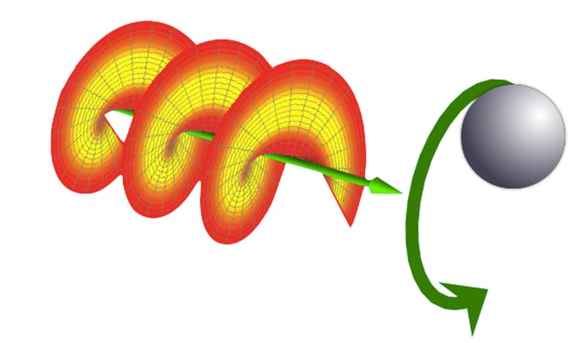There's big science news out of Ireland today that fundamentally alters the way we study and investigate the nature of light: physicists from Trinity College Dublin's School of Physics have discovered a new form of light.
It's made of photons that travel differently than any other light scientists have previously observed.
The breakthrough was made during an investigation into the angular momentum of light, which is what happens when something can be rotated around the axis along whatever it's traveling with. While we think of a light beam as a straight line, imagine it moving in a corkscrew motion around a central axis:
Similarly, angular momentum is observable in light, although up until now scientists thought this rotation was caused by an integer multiple of Planck's constant.
The new findings, published in Science Advances, illustrate how photons can exhibit angular momentum at actually half the values. Using a setup that twists a light beam through a crystalline material, the research team found that half-multiples of Planck's constant could result in angular velocity.
This is an incredibly cool new addition to the body of knowledge in physics, but it's much more difficult to ascertain exactly how scientists might use these findings for practical purposes. The research team writes in the paper that they hope this new form of light could play a role in the development of nanophotonics technology (read: futuristic solar cells, chemical spectroscopy, and microscopy to determine the composition of a substance, and microelectronics), as well as communications instruments that utilize light beams to encode and transfer data back and forth.
Engineers might also find a way to use the data to create new metamaterials that change the reflection and refraction of light to essentially provide a cloaking mechanism.
"Our discovery will have real impacts for the study of light waves in areas such as secure optical communications," said physicist and study coauthor John Donegan about his work.
- Where Are the Robot Musicians? Computer Scientists Struggle to Program Daft Punk
- Hacking Experts Say John McAfee's Cyberattack Warnings Will Make America Safer
- Has Technology Made Us All Bad Spellers?
- Montana Collector Discovers 'Judith' Dinosaur, Keeps the Dream Alive For All of Us
- New Research Reveals Giant Tsunami Remnants on Mars
Photos via By E-karimi (Own work) [CC BY-SA 3.0 (http://creativecommons.org/licenses/by-sa/3.0)], via Wikimedia Commons


